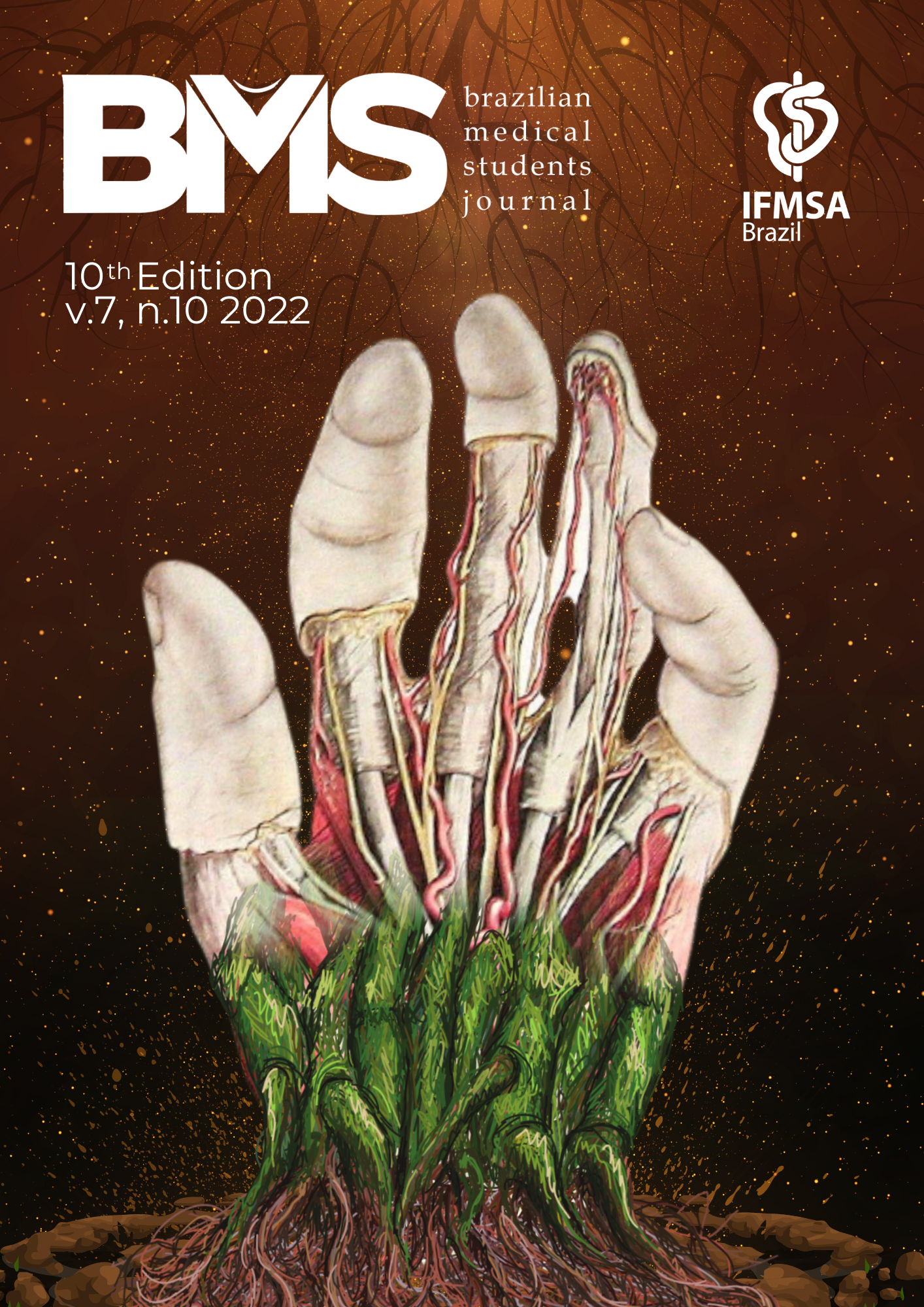RELATO DE CASO: SIRENOMELIA ASSOCIADA A DEFEITOS CONGÊNITOS RAROS
DOI:
https://doi.org/10.53843/bms.v7i10.363Palabras clave:
Anormalidades Congênitas, Anormalidades Musculoesqueléticas, SirenomeliaResumen
Introdução: Sirenomelia é uma anomalia congênita rara que afeta a formação dos membros inferiores, normalmente pareados por um único membro ao nível da linha média, geralmente está associada a defeitos no trato gênito-urinário. Relato do Caso: Caso de necropsia de recém-nascido com diagnóstico ultrassonográfico de sirenomelia que foi a óbito minutos após o nascimento. Entre os achados pós mortem destacam-se: malformações do sistema geniturinário e colônico, formação incompleta da coluna lombossacra, deformidade vascular aórtica, hipoplasia pulmonar e sinais de sofrimento fetal agudo, que se apresentava com membro inferior único composto de fêmures parcialmente fusionados e fíbula única. O diagnóstico final foi de Sirenomelia - tipo IV da Classificação de Stocker-Heifetz. Discussão:: A fisiopatologia da sirenomelia ainda não é bem definida, no entanto duas hipóteses que não se excluem são consideradas na literatura: a vascular e a blastogênica. A primeira propõe que a presença de artéria umbilical única aberrante provoque uma má irrigação arterial da porção inferior do feto; resultando em um subdesenvolvimento que caracteriza a sirenomelia. Já a blastogênica, explica a doença como um defeito primário durante a fase final da gastrulação, na qual ocorre falhas dos somitos caudais e do botão caudal. Conclusão: A sirenomelia é frequentemente associada à outros defeitos congênitos, afetando a formação de viscerais urogenitais e gastrointestinais, como agenesia renal unilateral ou bilateral, ausência de genitália externa, atresia anorretal e vascularização abdominal arterial aberrante. As malformações presentes em órgãos vitais são determinantes para o prognóstico e sobrevida do recém-nato.
PALAVRAS-CHAVE: Anormalidades Congênitas; Anormalidades Musculoesqueléticas; Sirenomelia
Métricas
Citas
- Stevenson RE, Hall J, eds. Human malformations and related anomalies. Oxford University Press, 2005.
- Dharmraj M, Gaur S. Sirenomelia: a rare case of foetal congenital anomaly. J Clin Neonatol. 2012 Oct;1(4):221-3.
- Lhuaire M, Jestin A, Boulagnon C, Loock M, Doco-Fenzy M, Gaillard D, et al. Sirenomelia: a new type, showing VACTERL association with Thomas syndrome and a review of literature. Birth Defects Res A Clin Mol Teratol. 2013 Mar;97(3):123-32.
- Boer LL, Morava E, Klein WM, Schepens-Franke AN, Oostra RJ. Sirenomelia: A Multisystemic Polytopic Field Defect with Ongoing Controversies. Birth Defects Res. 2017 Jun 1;109(10):791-804.
- Lima MAFD, Machado HN, Dock DCA, Villar MAM, Junior JCL. Sirenomelia associada a defeitos congênitos raros: relato de três casos. Jornal Brasileiro de Patologia e Medicina Laboratorial. 2012 ago; 48 (4):287-292
- Xu T, Wang X, Luo H, Yu H. Sirenomelia in twin pregnancy: A case report and literature review. Medicine (Baltimore). 2018 Dec;97(51):e13672.
- Orioli IM, Amar E, Arteaga-Vazquez J, Bakker MK, Bianca S, Botto LD, et al. Sirenomelia: an epidemiologic study in a large dataset from the International Clearinghouse of Birth Defects Surveillance and Research, and literature review. Am J Med Genet C Semin Med Genet. 2011 Nov 15;157C(4):358-73.
- Opitz JM, Zanni G, Reynolds JF Jr, Gilbert-Barness E. Defects of blastogenesis. Am J Med Genet. 2002 Dec 30;115(4):269-86.
- Garrido-Allepuz C, Haro E, González-Lamuño D, Martínez-Frías ML, Bertocchini F, Ros MA. A clinical and experimental overview of sirenomelia: insight into the mechanisms of congenital limb malformations. Dis Model Mech. 2011 May;4(3):289-99.
- Stocker JT, Heifetz SA. Sirenomelia. A morphological study of 33 cases and review of the literature. Perspect Pediatr Pathol. 1987;10:7-50.
- Agami-Micha S, Braverman-Bronstein A. Sirenomelia: reporte de un caso y revisión de la literatura. Revista Mexicana de Pediatría. 2015; 82 (3): 98-100.
- Duncan PA, Shapiro LR. Interrelationships of the hemifacial microsomia-VATER, VATER, and sirenomelia phenotypes. Am J Med Genet. 1993 Aug 1;47(1):75-84.
Descargas
Publicado
Cómo citar
Número
Sección
Licencia
Derechos de autor 2022 Samya Hamad Mehanna, Fabio Kendi Kunitake, Rodrigo Voichki Rodrigues, Tatiana De Souza Bem

Esta obra está bajo una licencia internacional Creative Commons Atribución 4.0.
Las licencias de usuario definen cómo los lectores y el público en general pueden utilizar el artículo sin requerir otros permisos. Las licencias públicas Creative Commons proporcionan un conjunto estándar de términos y condiciones que los creadores y otros titulares de derechos pueden utilizar para compartir obras originales de autoría y otros materiales sujetos a derechos de autor y otros derechos específicos especificados en la licencia pública disponible en https:// creativecommons.org /licenses/by/4.0/deed.pt_BR. Al utilizar la Licencia Pública Internacional 4.0, los Estudiantes de Medicina de Brasil (BMS) otorgan al público permiso para utilizar el material publicado en los términos y condiciones especificados y acordados por la revista. Al ejercer los derechos de licencia, los autores aceptan y aceptan estar sujetos a los términos y condiciones de la Licencia Pública Internacional Creative Commons Attribution 4.0.






